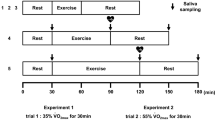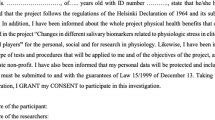The dynamics of salivary hydrocortisone during exercise depends on the professional status of the athlete. Hydrocortisone concentrations increase and those of secretory IgA decrease significantly during short-term highly intense exercise. Presumably, basal serum hydrocortisone level is the key factor in restoration of the secretory IgA concentration after exercise by inhibition of lymphocyte, macrophage, and monocyte functions through an increase in glucocorticoid level under the effect of physiological stressors.
Similar content being viewed by others
References
D. A. Sakharov, A. V. Stepanov, M. U. Shkurnikov, and A. G. Tonevitsky, Byull. Eksp. Biol. Med., 147, No. 3, 335–340 (2009).
S. A. Khaustova, M. U. Shkurnikov, E. S. Grebenyuk, et al., Ibid., 148, No. 11, 597–600.
J. P. Ahtiainen, A. Pakarinen, M. Alen, et al., Eur. J. Appl. Physiol., 89, No. 6, 555–563 (2003).
T. Akimoto, Y. Kumai, T. Akama, et al., Br. Sports Med., 37, No. 1, 76–79 (2003).
M. Bouget, M. Rouveix, O. Michaux, et al., J. Sports Sci., 24, No. 12, 1297–1302 (2006).
J. L. Chicharro, A. Lucia, M. Pérez, et al., Sports Med., 26, No. 1, 17–27 (1998).
B. T. Crewther, T. Lowe, R. P. Weatherby, et al., J. Strength Cond. Res., 23, No. 7, 2046–2053 (2009).
M. Hasegawa, M. Toda, and K. Morimoto, Biomed. Res., 29, No. 1, 43–46 (2008).
J. A. Hawley, M. J. Gibala, S. Bermon, et al., J. Sports Sci., 25, Suppl. 1, S115–S124 (2007).
J. G. Lewis, Clin. Biochem. Rev., 27, No. 3, 139–146 (2006).
L. T. Mackinnon, E. Ginn, and G. J. Seymour, Eur. J. Appl. Physiol. Occup. Physiol., 67, No. 2, 180–184 (1993).
S. L. McDowell, K. Chaloa, T. J. Housh, et al., Ibid., 63, No. 2, 108–111 (1991).
A. Moreira, F. Arsati, Y. B. de Oliveira Lima Arsati, et al., Eur. J. Appl. Physiol., 106, No. 1, 25–30 (2009).
N. P. Walsh, N. C. Bishop, J. Blackwell, et al., Med. Sci. Sports Exerc., 34, No. 10, 1632–1637 (2002).
N. P. Walsh, A. K. Blannin, A. M. Clark, et al., J. Sports Sci., 17, No. 2, 129–134 (1999).
Author information
Authors and Affiliations
Additional information
Translated from Byulleten’ Eksperimental’noi Biologii i Meditsiny, Vol. 149, No. 5, pp. 569–573, May, 2010
Rights and permissions
About this article
Cite this article
Khaustova, S.A., Shkurnikov, M.U. & Tonevitsky, A.G. Short Highly Intense Exercise Causes Changes in Salivary Concentrations of Hydrocortisone and Secretory IgA. Bull Exp Biol Med 149, 635–639 (2010). https://doi.org/10.1007/s10517-010-1012-2
Received:
Published:
Issue Date:
DOI: https://doi.org/10.1007/s10517-010-1012-2




